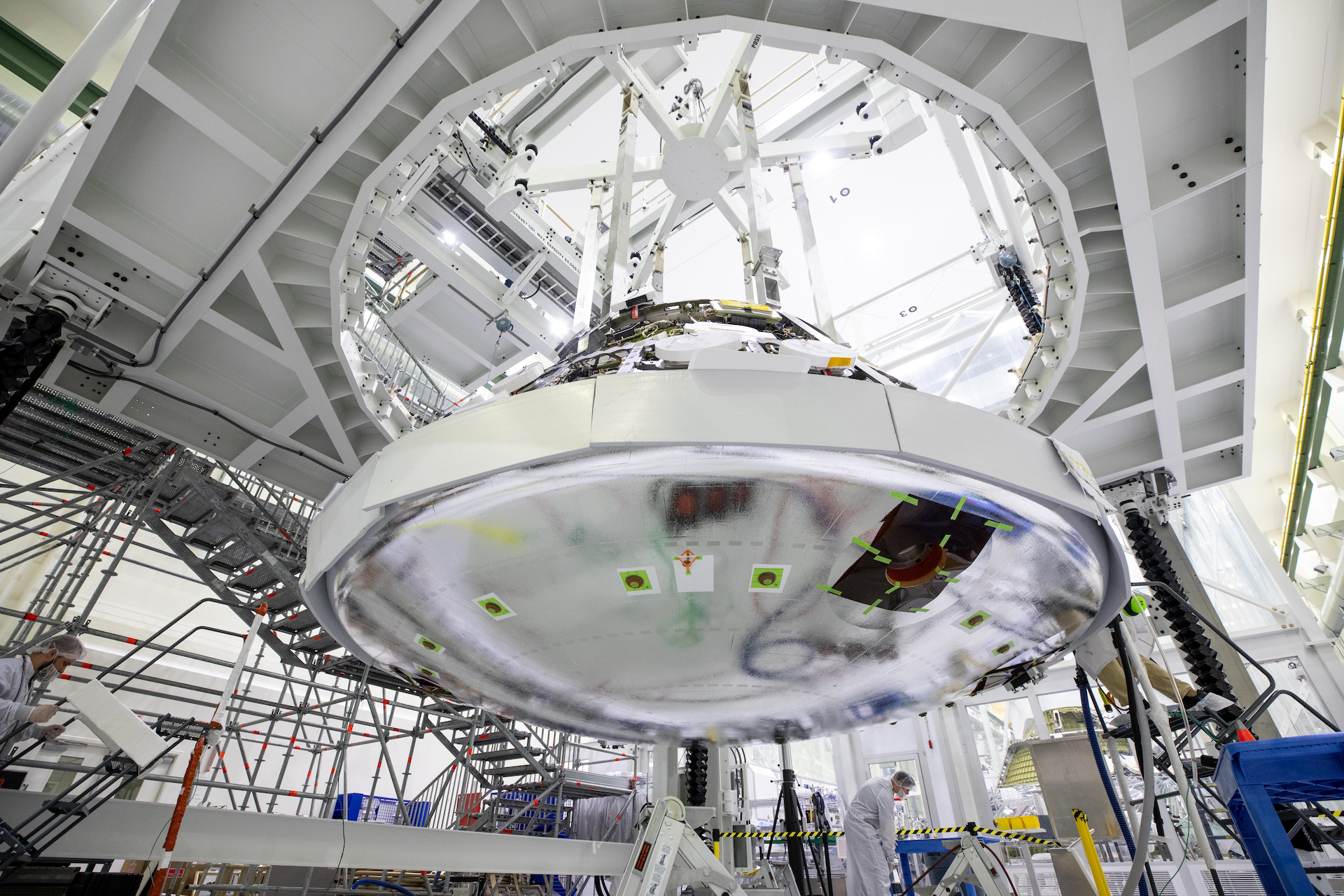Orion spacecraft gets its heat shield for Artemis 2 moon mission (photo)
Artemis 2's Orion capsule now has a thermal protection system.

NASA is making headway in its preparations for the Artemis 2 mission, which will send astronauts on a mission around the moon.
Technicians at NASA's Kennedy Space Center (KSC) in Florida have attached the heat shield to the Artemis 2 Orion spacecraft.
Orion and its four-person crew are scheduled to launch atop NASA's Space Launch System (SLS) rocket on Artemis 2 in late 2024. The mission will carry them into deep space around the moon, farther than any human has ever flown.
Related: Watch NASA assemble the massive Artemis 2 rocket that will take humans back to the moon (video)
In November 2022, an uncrewed Orion capsule launched on Artemis 1, a 25-day trip to lunar orbit and back. Artemis 2 will employ a free-return trajectory profile, which forgoes an orbital injection burn at the moon and puts the spacecraft on a path back to Earth. So, the Artemis 2 crew will fly around the moon without actually entering its orbit.
Once Orion completes its lunar pass, the Artemis 2 crew will be on a course back to our big, blue marble, with nothing but Earth's atmosphere standing between them and the slow parachuted drop of a safe ocean splashdown. To protect the spacecraft and its astronaut crew as Orion punches through Earth's gaseous outer shell, its heat shield measures 16.5 feet (5 meters) in diameter, and covers the entire bottom of the vehicle.
As it returns from the moon, Orion will hit the atmosphere traveling more than 25,000 mph (40,230 kph). Temperatures on the capsule's exterior will get as high as 5,000 degrees Fahrenheit (2,760 degrees Celsius). Orion's heat shield will absorb the majority of that energy, enabling the cabin inside to remain at comfortable temperatures during the astronauts' fall back to Earth.
Get the Space.com Newsletter
Breaking space news, the latest updates on rocket launches, skywatching events and more!
Teams completed the Artemis 2 heat shield installation on June 25, inside the Neil Armstrong Operations and Checkout Building at KSC, according to NASA. Next, Orion's outer paneling will be secured and the spacecraft prepared for acoustic testing.
Orion has additional hardware installations and vehicle qualifications to endure before it is declared space-worthy, however. NASA is currently targeting the end of 2024 for the launch of Artemis 2, which will fly humans to the moon for the first time since the Apollo program ended more than 50 years ago.
Join our Space Forums to keep talking space on the latest missions, night sky and more! And if you have a news tip, correction or comment, let us know at: community@space.com.

Josh Dinner is the Staff Writer for Spaceflight at Space.com. He is a writer and photographer with a passion for science and space exploration, and has been working the space beat since 2016. Josh has covered the evolution of NASA's commercial spaceflight partnerships and crewed missions from the Space Coast, as well as NASA science missions and more. He also enjoys building 1:144-scale model rockets and human-flown spacecraft. Find some of Josh's launch photography on Instagram and his website, and follow him on X, where he mostly posts in haiku.
-
Wisetoe A KINETIC ENERGY CONVERTER (KEC)Reply
When material science improves, Starships returning to Earth will have a different heat dissipation. One that is efficient and simple.
My suggestion is an additional outer skin on each section. A ten mm clearance is required to house thousands of nine mm long radial spikes pointing inwards, thus magnifying heat dissipation.
Superheated steam can be ejected through external venturis to add thrust against the atmosphere. Heat tiles can be minimized because the best part is no part.
PS This KEC could be used on the Orion. Would someone do the mathematics? KE = Latent Heat of Super Heated Steam. This leads to kgs of water required to replace the heat tiles. -
Wisetoe A Slip-on Heat ShieldReply
Now that a rethinking of theStarship's heat shield is occurring, SpaceX must be tempted to swap 28,000 tiles for a Slip-0n Heat Shield that has been separately launched into Space. Exotic designs could be created without the weight constraints of having it attached to the Starship.The kinetic energy could possibly be stored for some Earthly or Martian use.
One idea is the Kinetic EnergyConverter previously mentioned.
Comments are greatly appreciated,
Wisetoe. December, 2024 -
Wisetoe 15/01/25Reply
An Orbital Refuelling Space Station
I admit I am an omega trying to copy the alpha, and I think that hanging all that weight on a rocket for it's return to Earth violates the principle of simplicity.
Why pick the most violent environment; the last 100kms to ditch the kinetic energy? I know I will be crucified by all who know better, but tell me what is wrong with using the much friendlier vacuum of open space.









